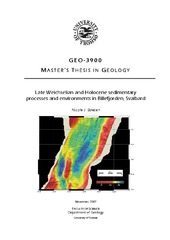| dc.contributor.advisor | Vorren, Tore O. | |
| dc.contributor.advisor | Forwick, Matthias | |
| dc.contributor.author | Baeten, Nicole Jeanne | |
| dc.date.accessioned | 2007-12-21T10:08:42Z | |
| dc.date.available | 2007-12-21T10:08:42Z | |
| dc.date.issued | 2007-11 | |
| dc.description.abstract | Three sediment cores, swath multibeam bathymetry data and high-resolution seismic data from Billefjorden, Svalbard have been analysed for a better understanding of the Late Weichselian and Holocene glacier activity as well as sedimentary process and glacigenic deposits in the fjord. The data reveal that glacial linear features were generated in the central part of Billefjorden while it was filled with ice draining the Svalbard-Barents Sea ice sheet during the Last Glacial. A till in the bottom of a sediment core from the central part of the fjord is inferred to have been deposited before the ice front retreated into Billefjorden around 11230 cal. years BP. An overlying glacimarine unit deposited between c. 11230 and 11200 cal. years BP indicates that the glacier retreated from central parts of the fjord to the fjord head in approximately 30 years. Annual recessional moraines deposited during this period suggest that the glacier front retreated approximately 330 m/ year at the end of the last Glacial. High concentration of shells, low amounts of IRD and XRD results indicate a Holocene climatic optimum between c. 11200 – 7930 cal. years BP in which Nordenskiöldbreen was most likely much smaller than it is at present. XRD results and comparatively high amounts of IRD point to a complex pattern of ice rafting between c. 7930 and 3230 cal. BP. IRD deposited before c. 5470 cal. years BP was most likely transported by sea ice, whereas IRD after 5470 cal. years points towards a growth of Nordenskiöldbreen. The time after c. 3230 is mainly characterised by suppressed rafting of sea ice and icebergs because of the possible presence of multi-year shorefast sea ice during the Neoglacial maximum. Glacial lineations on a bedrock terrace in the inner fjord were formed during a Neoglacial advance of Nordenskiöldbreen. Iceberg ploughmarks and recessional moraines were most likely generated during the retreat after the maximum Neoglacial extent of Nordenskiöldbreen. Mass-transport activity in Billefjorden probably occurred throughout the entire Holocene. There might haven been an increased mass-transport activity shortly after the deglaciation of the fjord, because high rates of isostatic uplift might have caused seismic activity. Other triggering mechanisms include the development of oversteepened slopes by high sediment supply and the pushing of sediments at the grounding line of the glacier. Pockmarks in the central part of the fjord were most likely generated by the seepage of thermogenic gas along the Billefjorden fault zone. | en |
| dc.format.extent | 2065 bytes | |
| dc.format.extent | 42431196 bytes | |
| dc.format.mimetype | text/plain | |
| dc.format.mimetype | application/pdf | |
| dc.identifier.uri | https://hdl.handle.net/10037/1274 | |
| dc.identifier.urn | URN:NBN:no-uit_munin_1082 | |
| dc.language.iso | eng | en |
| dc.publisher | Universitetet i Tromsø | en |
| dc.publisher | University of Tromsø | en |
| dc.rights.accessRights | openAccess | |
| dc.rights.holder | Copyright 2007 The Author(s) | |
| dc.subject.courseID | GEO-3900 | nor |
| dc.subject | VDP::Mathematics and natural science: 400::Geosciences: 450::Marine geology: 466 | en |
| dc.title | Late Weichselian and Holocene sedimentary processes and environments in Billefjorden, Svalbard | en |
| dc.type | Master thesis | en |
| dc.type | Mastergradsoppgave | en |


 English
English norsk
norsk